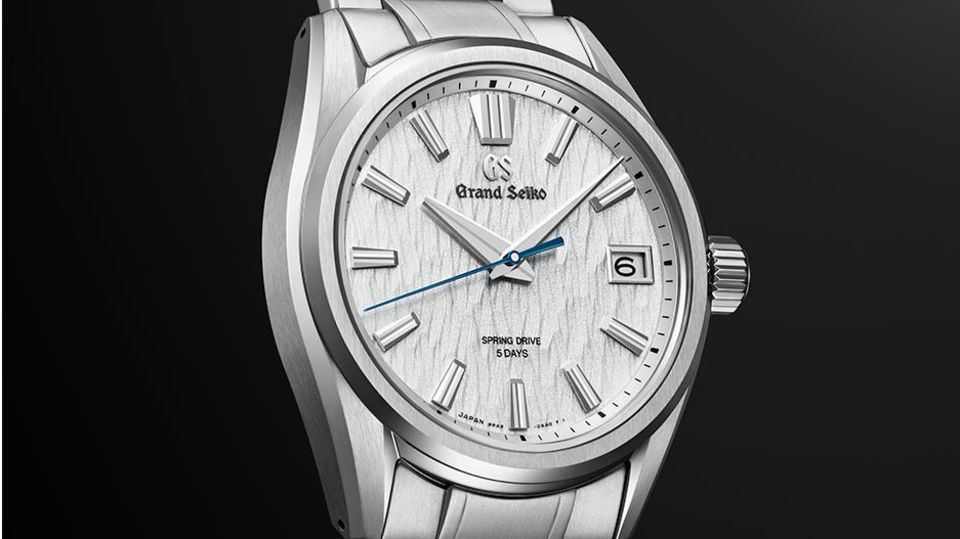Among connoisseurs, Grand Seiko has been a fixture in the watch world for years – and doesn’t have to hide from top dogs like Rolex and Omega. Nevertheless, the brand is comparatively invisible. Frédéric Bondoux, Grand Seiko boss in Europe, reveals in an interview how he wants to change that.
Mr. Bondoux, let’s assume that many people, even those who are interested in watches, don’t really know the difference Seiko and Grand Seiko differ – except perhaps in price. What distinguishes the two brands that share the name?
Frédéric Bondoux: To put it briefly: we have the same history, but not the same fate. Grand Seiko was born in 1960 thanks to Seiko and was still part of the Seiko collection until 2017. Then they parted ways. Seiko offers great value for money, while Grand Seiko focuses on high watchmaking and craftsmanship excellence.
But that was always the core idea, wasn’t it?
Absolutely. Even in the 1960s, Grand Seiko was considered relatively expensive and luxurious and was aimed at the aristocracy and elite in Japan. That hasn’t changed since 2010, when Grand Seiko went international.
What makes a Grand Seiko in your eyes?
Above all, Grand Seiko stands for a lot of handwork and real watchmaking art. Craftsmanship and tradition mean a lot to the Japanese – and Grand Seiko combines this in its watches. Seiko, on the other hand, is a high-quality mass-produced product, but does not require comparable hours of work per watch.
How many examples does Grand Seiko produce each year?
I won’t reveal this number, but it’s only a few tens of thousands.
Just a few years ago, Grand Seiko was considered the ultimate insider tip among watch connoisseurs. Back then it was said: You can’t get more watch for your money. The prices have now risen quite a bit.
That’s correct. I would say that after the introduction of the new movements the prices also increased. The brand currently has an average price of around 8,000 euros – that used to be 5,000. What is giving Grand Seiko a hard time in this regard is the exchange rate between the euro and the yen.
So is it worth it to buy a watch in Japan if you’re going to be there anyway?
Unfortunately, that’s true. The list prices in Japan are not adjusted to the weak yen and therefore the watches there cost the equivalent of a few thousand euros less. This is still financially worthwhile, even with customs duties and import sales tax. Our customers benefit from local production in Japan – other watches, such as Swiss makes, have become very expensive in Japan.

Speaking of other brands: Which major manufacturer would you place Grand Seiko’s quality next to – more like Rolex or almost Patek Philippe?
I won’t mention other brands, but about Grand Seiko they say that it is the watch for 5000 euros that is worth 50,000. I think that says a lot about how our watches are perceived. This is certainly also due to the fact that many of the work steps on a Grand Seiko are purely manual work, which has become quite rare in Switzerland. But it’s not a brand to brag about, if that was the question.
“Is Grand Seiko perhaps not visible enough?”
Almost – it’s actually only coming now. How would you convince someone to buy a Grand Seiko when they’re actually more interested in Rolex or Omega in a boutique because those are the stories they buy?
This customer will buy a Rolex or an Omega because that was already a given. Grand Seiko is aimed at customers who are open to something different or who feel connected to Japanese culture. When it comes to technology and quality, we are on the same or better level, but the Swiss’ marketing is much louder.
Is Grand Seiko perhaps not visible enough?
We are working hard on it. In the future, we will therefore rely on our own stores or concessionaires that carry comparable brands. It is becoming increasingly rare to find Grand Seiko in Seiko boutiques.

Although the crown jewel, the Spring Drive movement, is actually a Seiko invention and I always thought it was something like that that held houses together.
Seiko decided early on that the Spring Drive movement would be reserved for high-priced watches. That doesn’t change anymore. The unique combination of the advantages of a quartz watch with the fascination of a mechanical movement makes us who we are. In Europe, Spring Drive watches account for just over half of all sales. And this despite the fact that we also offer really great quartz movements and purely mechanical watches.
Now Quartz has a difficult time in Germany anyway.
That’s probably true. The market share of our quartz watches in Europe is around 10 percent. The remaining 40 percent then goes to mechanical watches. In Japan things are very different.
They like quartz there, which is decried as cheap?
As far as market share is concerned, we have up to 25 percent at home. People there tend to understand that there are also huge differences in quality when it comes to battery-operated watches – not all quartz are the same.
What makes the difference? It won’t be the button cell.
It’s like with mechanical clockworks. The number and quality of parts varies, which in turn affects the accuracy and durability of the watches. A high-quality quartz movement can even be very beautiful – that is also the reason why we use glass bottoms even for these calibres.
GPHG 2023
The “Oscars of the watch world”: According to Swiss experts, these are the best luxury watches of the year
How does maintenance work for your brand?
It depends. We cover a lot of things with our service center in Rotterdam. But especially when it comes to polishing the watch, which we know as Zaratsu polissage, the watch has to go to Japan. Only very few watchmakers who have trained for this for years can do this. With the very high-quality watches, this even goes so far that we only allow the watchmaker who originally made them to carry out the overhaul.
Doesn’t the service take years?
For a normal submission for Japan we are talking about three to four months. That’s how long the revision takes for some Swiss people – and that’s without transport to Japan.
How often do I need to have my Grand Seiko serviced?
Only if it’s defective. I don’t have a fixed guideline. In the end, everyone has to know that for themselves. As long as the clock is running, you can avoid any contact with us for 15 years or longer. Some regularly send in their watches every five to eight years.
Source: Stern
I am an author and journalist who has worked in the entertainment industry for over a decade. I currently work as a news editor at a major news website, and my focus is on covering the latest trends in entertainment. I also write occasional pieces for other outlets, and have authored two books about the entertainment industry.




